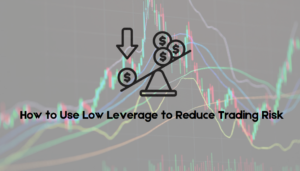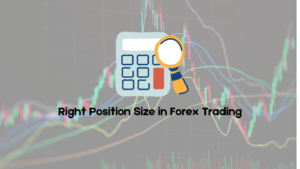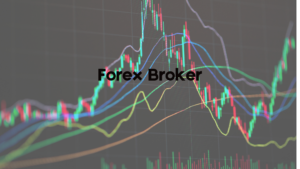A Stop Order in Forex is a type of order designed to limit an investor’s loss or lock in a profit by triggering a trade when the price of a currency pair reaches a specified level. Essentially, it becomes a market order when the stop price is hit. There are two main types of stop orders: stop-loss orders and stop-limit orders. A stop-loss order is used to exit a losing position, while a stop-limit order allows traders to set both a stop price and a limit price, adding more control over the execution.
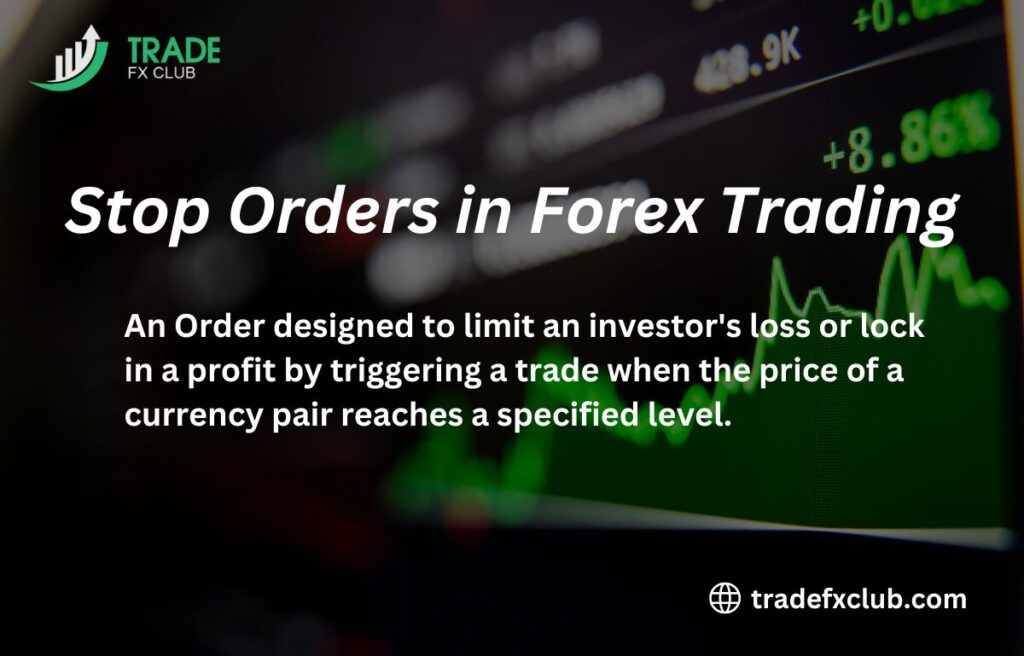
For example, if a trader holds a long position in EUR/USD and wants to limit potential losses, they might set a stop-loss order below the current market price. If the EUR/USD falls to this level, the stop order is triggered, and the trade is executed at the next available market price. This mechanism helps manage risk by ensuring that losses do not exceed a predetermined level.
How Does a Stop Order Work in Forex Trading?
When a stop order is placed, it remains inactive until the market price reaches the stop price set by the trader. Once the market price hits this stop level, the stop order is activated and becomes a market order, which means it will be executed at the best available price. This price may be different from the stop price, particularly in volatile markets, due to slippage—the difference between the expected price and the actual execution price.
For instance, if you set a stop order for EUR/USD at 1.1000, and the price falls to this level, the stop order will trigger. If the market is moving quickly, the execution might occur at 1.0998 or 1.1002, depending on available liquidity. Traders should be aware of potential slippage and market conditions when using stop orders.
Why Use Stop Orders in Forex Trading?
Stop orders are essential tools for risk management in Forex trading. They help traders prevent significant losses by automatically closing positions when the market moves against them. By setting a stop-loss order, traders define their maximum acceptable loss and protect their trading capital, which is crucial for long-term success in the volatile Forex market.
Additionally, stop orders can be used to lock in profits as the market moves favourably. For example, a trader might use a trailing stop order, which adjusts the stop price as the market price moves in their favour. This strategy helps secure gains while still allowing for potential further profit if the market continues to move positively. Overall, stop orders are valuable for maintaining disciplined trading and managing risk effectively.
What are the Different Types of Stop Orders in Forex?
In Forex trading, there are several types of stop orders, each serving different purposes based on the trader’s objectives. The two primary types are Stop-Loss Orders and Stop-Limit Orders, but there are variations like Trailing Stop Orders and Buy Stop Orders. Each type has its characteristics and applications in risk management and trade execution.
Stop-Loss Order: This is designed to minimise losses by automatically closing a position when the market price reaches a predetermined level. It acts as a safety net, helping traders limit their downside risk in volatile markets.
Stop-Limit Order: This order combines a stop order with a limit order, allowing traders to specify a stop price and a limit price. Once the stop price is triggered, the order becomes a limit order, meaning it will only be executed at the limit price or better.
Trailing Stop Order: This dynamic type of stop order adjusts the stop level as the market price moves in the trader’s favour. It locks in profits while allowing the position to remain open if the market continues to move positively.
Buy Stop Order: Used to enter a position, a Buy Stop Order is placed above the current market price. It triggers a buy order when the price reaches the stop level, often used to capitalise on upward momentum.
What is a Stop-Loss Order?
A Stop-Loss Order is a protective mechanism designed to limit potential losses on a trade. It is set at a specific price level below the market price for long positions or above the market price for short positions. If the market price reaches the stop level, the order is triggered, and the position is automatically closed at the best available market price. This helps prevent excessive losses if the market moves unfavourably.
For instance, if a trader buys EUR/USD at 1.1200 and sets a stop-loss order at 1.1150, the trade will be closed automatically if the price drops to 1.1150. This ensures that the trader does not lose more than 50 pips on the trade. Stop-loss orders are crucial for managing risk and protecting trading capital, especially in the volatile Forex market.
What is a Stop-Limit Order?
A Stop-Limit Order is a combination of a stop order and a limit order. It requires the trader to set two prices: the stop price and the limit price. When the market price reaches the stop level, the order is activated and becomes a limit order. This means that the order will only be executed at the limit price or better. The stop-limit order provides more control over the execution price compared to a standard stop-loss order.
For example, if a trader holds a position in USD/JPY and sets a stop price at 110.00 and a limit price at 109.80, the stop-limit order will trigger when the price hits 110.00. However, the trade will only be executed if the price can be filled at 109.80 or better. This type of order helps avoid unfavourable executions but may result in the order not being filled if the market moves too quickly beyond the limit price.
What is a Trailing Stop Order?
A Trailing Stop Order is a type of stop order that moves with the market price to lock in profits and limit potential losses. Unlike a standard stop order, which remains static at a set price level, a trailing stop adjusts dynamically as the market price moves in favour of the trade. It helps traders to capture gains as the market price improves while protecting against reversals by setting a predefined distance or percentage away from the current market price.
For example, if a trader sets a trailing stop of 50 pips on a long EUR/USD position, and the price rises from 1.1200 to 1.1250, the trailing stop will adjust upward to 1.1200 (50 pips below the new high). If the market then reverses and drops to 1.1200, the position will be closed, locking in profits. Trailing stops are particularly useful in trending markets, where they allow traders to benefit from prolonged price movements without constantly adjusting stop levels.
How to Place a Stop Order in Forex Trading Platforms?
Placing a stop-order on Forex trading platforms involves a few straightforward steps, though the exact process can vary slightly depending on the platform. Generally, you start by selecting the currency pair you wish to trade and then decide on the type of stop order you want to place (e.g., stop-loss, stop-limit, or trailing stop). Once you have chosen the type of stop order, you enter the specific stop price, and for stop-limit orders, you also specify the limit price.
For instance, on many platforms, you would navigate to the order entry section, select the “Stop” or “Stop-Loss” option and input the desired stop price. For a trailing stop, you would set the trailing amount or percentage. After confirming the details and reviewing your order, you can submit it. The platform will then monitor the market and execute the order according to the criteria you set when the stop price is reached.
What are the Risks Associated with Using Stop Orders in Forex?
While stop-orders are valuable for risk management, they come with certain risks. One significant risk is slippage, which occurs when the market moves rapidly, and the order is executed at a different price than the stop price. This can result in a trade being closed at a less favourable price than anticipated, especially in highly volatile market conditions.
Another risk is that stop-orders might not be executed at all if the market gaps past the stop price. For example, if the market opens significantly lower than the stop price due to news or events, the stop order might not be filled at the desired level, leading to greater losses. Additionally, in fast-moving or illiquid markets, the stop order might be filled at a price far from the stop level, impacting overall trading performance. It’s crucial for traders to be aware of these risks and to use stop orders as part of a comprehensive risk management strategy.
How Can Stop Orders Protect Your Forex Trades?
Stop-orders are essential tools for protecting Forex trades by providing a predefined mechanism for managing risk. A stop-loss order automatically closes a position when the market price reaches a specified level, preventing further losses beyond this point. This predefined exit strategy is crucial for traders who want to avoid emotional decision-making and ensure that losses are contained within acceptable limits.
Moreover, stop-orders can also be used to lock in profits as the market moves favourably. For example, a trailing stop order adjusts dynamically with the market price, allowing traders to secure gains while still leaving room for potential further profits. This automatic adjustment helps protect profits from being eroded by market reversals, making stop orders a valuable tool for maintaining discipline and safeguarding trading capital.
When Should You Use a Stop Order in Forex?
Stop-orders should be used in Forex trading whenever you want to manage risk and protect your position from adverse market movements. They are particularly useful when entering trades where you are unsure of the potential volatility or when trading in highly unpredictable markets. By setting a stop-loss order at a predetermined level, you can limit potential losses if the market moves against your position.
Additionally, stop-orders are beneficial when you want to lock in profits on a winning trade. For example, once a trade has moved significantly in your favour, using a trailing stop-order can help you secure gains while still allowing for potential upside. Employing stop-orders in these scenarios helps to maintain a balanced risk-reward profile and avoids emotional trading decisions.
What Factors Should Influence Your Stop Order Placement?
Several factors should influence the placement of stop-orders in Forex trading. First, market volatility plays a crucial role. In highly volatile markets, wider stop distances may be necessary to avoid premature stop-outs due to normal price fluctuations. Conversely, in more stable markets, tighter stop levels can be appropriate to minimise potential losses.
Another factor is the trader’s risk tolerance and trading strategy. Stop orders should align with your risk management rules, such as the percentage of capital you are willing to risk on a single trade. Additionally, technical analysis can inform stop placement, such as setting stops below key support levels for long positions or above resistance levels for short positions. Integrating these factors ensures that stop orders are effectively tailored to your trading plan and market conditions.
How Do Stop Orders Impact Forex Trading Strategies?
Stop orders significantly impact Forex trading strategies by introducing a structured approach to risk management and trade execution. By defining exit points before entering a trade, stop orders help traders maintain discipline and adhere to their trading plans. This prevents emotional decision-making and ensures that losses are controlled, which is vital for long-term trading success. For example, incorporating stop-loss orders into a trading strategy allows traders to set predefined risk levels and avoid substantial losses if the market moves unfavourably.
Additionally, stop-orders can complement various trading strategies, such as trend following or breakout strategies. For instance, traders using a trend-following strategy might place a trailing stop order to lock in profits as the trend continues. Similarly, in breakout strategies, a stop order can be used to manage risk if the breakout fails and the market reverses. Overall, stop orders integrate seamlessly into trading strategies, providing both protection and flexibility.
How Can You Optimise Stop Order Placement in Forex?
Optimising stop order placement involves several key considerations to balance risk and reward effectively. First, analyse market volatility and price action to determine an appropriate stop level. In highly volatile conditions, wider stop levels may be necessary to account for significant price swings, while in less volatile markets, tighter stops can be used to minimise losses. Understanding the average true range (ATR) of the currency pair can provide insights into setting stops that are appropriate for current market conditions.
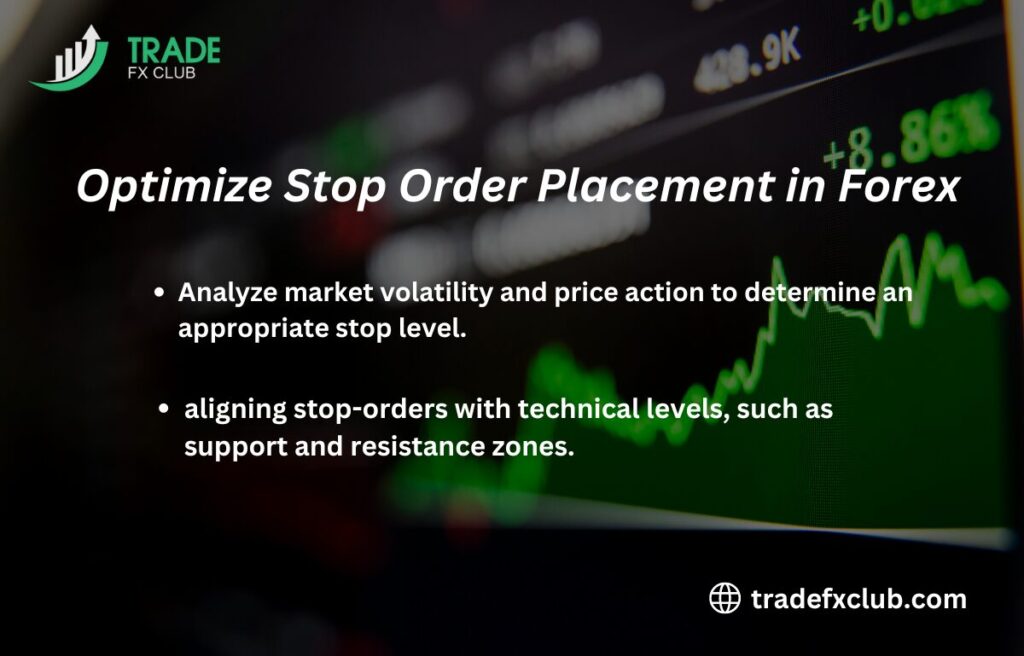
Another important aspect is aligning stop-orders with technical levels, such as support and resistance zones. For instance, placing a stop-loss order just below a significant support level for a long position can help avoid premature stop-outs if the market experiences a minor dip. Additionally, consider your risk tolerance and trading strategy when placing stops. Ensuring that your stop levels are consistent with your overall risk management plan and trading goals will optimise your stop order placement and enhance your trading effectiveness.
What are Common Mistakes When Using Stop Orders in Forex?
Common mistakes when using stop orders in Forex include setting stop levels too tight or too wide relative to market conditions. Placing a stop order too close to the entry price can result in frequent stop-outs due to normal market fluctuations, while a stop placed too far away may expose the trader to excessive losses. It’s essential to balance the distance of your stop orders with market volatility and the specific characteristics of the currency pair you are trading.
Another mistake is failing to adjust stop orders in response to changing market conditions. For instance, not moving a trailing stop-order in a trending market can lead to missed opportunities to lock in profits. Additionally, some traders may not use stop-orders at all, exposing themselves to higher risks and potential losses. To avoid these mistakes, it is crucial to regularly review and adjust stop orders based on market behaviour, volatility, and your trading plan.
What Tools Can Help with Stop Order Execution in Forex?
Several tools and features available on Forex trading platforms can help with the effective execution of stop-orders. Trading platforms like MetaTrader 4/5, cTrader, and others offer built-in functionalities for setting and managing stop-orders. These platforms allow traders to easily place stop-loss, stop-limit, and trailing stop orders directly from the trade entry interface, often with visual tools like charts to aid in setting stop levels.
Additionally, risk management tools such as automated trading systems or expert advisors (EAs) can enhance stop order execution. EAs can be programmed to automatically adjust stop orders based on predefined criteria, such as trailing stop adjustments or dynamic risk management. These tools help ensure that stop orders are managed efficiently, even in fast-moving markets or when the trader is not actively monitoring their positions.
How Do Market Conditions Affect Stop Orders in Forex?
Market conditions play a crucial role in the effectiveness of stop-orders. Volatility can impact stop order execution, as high volatility may lead to slippage—where the actual execution price differs from the stop price due to rapid price changes. In such conditions, stop orders might be executed at a less favourable price than intended, potentially increasing losses.
Market liquidity also affects stop orders. In illiquid markets, there may be insufficient buyers or sellers at the stop price, leading to wider spreads or slippage. During major news events or market openings, liquidity can be temporarily reduced, which might result in stop orders being filled at unexpected prices. Traders need to consider these factors and adjust their stop orders accordingly to mitigate potential adverse effects.
What is the Difference Between Stop Orders and Limit Orders in Forex?
Stop-orders and limit orders serve different purposes in Forex trading, though both are essential for managing trades. Stop orders are designed to activate a trade when the market price reaches a specified stop level. For example, a stop-loss order closes a position when the price hits a stop level, helping limit losses. Conversely, a buy-stop order initiates a new buy position when the price rises to the stop level.
Limit orders, on the other hand, are used to set a specific price at which you want to buy or sell a currency pair. A buy limit order is placed below the current market price, and it will only execute if the market price drops to the limit price. A sell limit order is placed above the current market price, and it will only execute if the price rises to the limit price. Unlike stop-orders, limit orders do not guarantee execution, as the price must reach the specified level for the order to be filled.
How Do Stop Orders Affect Market Volatility in Forex?
Stop-orders can influence market volatility in Forex trading, though their primary purpose is to manage risk rather than directly affect volatility. When a large number of stop-loss orders are clustered at similar price levels, they can create significant market reactions once the stop levels are triggered. This clustering can lead to sharp price movements as the execution of these stop orders may cause a cascade of additional stop orders being triggered, amplifying market volatility.
For example, if many traders have set stop-loss orders at a common support level, a breach of this level could lead to a rapid sell-off, driving the price down further and causing increased volatility. This effect can be particularly pronounced during news events or market openings when liquidity is lower and price swings are more dramatic. Therefore, while stop orders help manage individual risk, their collective impact can contribute to short-term market volatility.
What Role Does Stop Orders Play in Automated Forex Trading?
In automated Forex trading, stop-orders play a critical role in implementing predefined risk management strategies without manual intervention. Automated trading systems or expert advisors (EAs) use stop orders to execute trades based on specific algorithms and criteria. For instance, an EA might place stop-loss orders to automatically exit a position if the market moves against it, ensuring that losses are contained as per the trading strategy.
Additionally, stop-orders in automated systems can be used to dynamically adjust trading positions. For example, a trailing stop-order can be set to move with the market price, locking in profits while allowing for further gains. This automation of stop orders allows traders to maintain disciplined trading practices and manage risk effectively, even when they are not actively monitoring the market.
How to Manage Multiple Stop Orders in Forex Trading?
Managing multiple stop-orders in Forex trading requires organisation and strategic planning. Traders often use trading platforms that offer features for monitoring and managing multiple orders simultaneously. Features such as order management screens and custom alerts help traders keep track of all active stop orders and their status.
Group orders based on their strategic purpose or currency pairs can also simplify management. For instance, grouping stop-orders related to the same trading strategy or currency pair can streamline monitoring and adjustment processes. Additionally, some traders use trade management tools or portfolio management software to consolidate and manage multiple stop orders effectively, ensuring that each order aligns with the overall trading strategy and risk management plan.
What is the Relationship Between Stop Orders and Risk Management in Forex?
Stop orders are integral to effective risk management in Forex trading. They provide a systematic way to limit potential losses and protect trading capital by specifying exit points in advance. By setting stop-loss orders, traders can define their maximum acceptable loss for each trade, ensuring that they do not exceed their risk tolerance and maintaining disciplined trading practices.
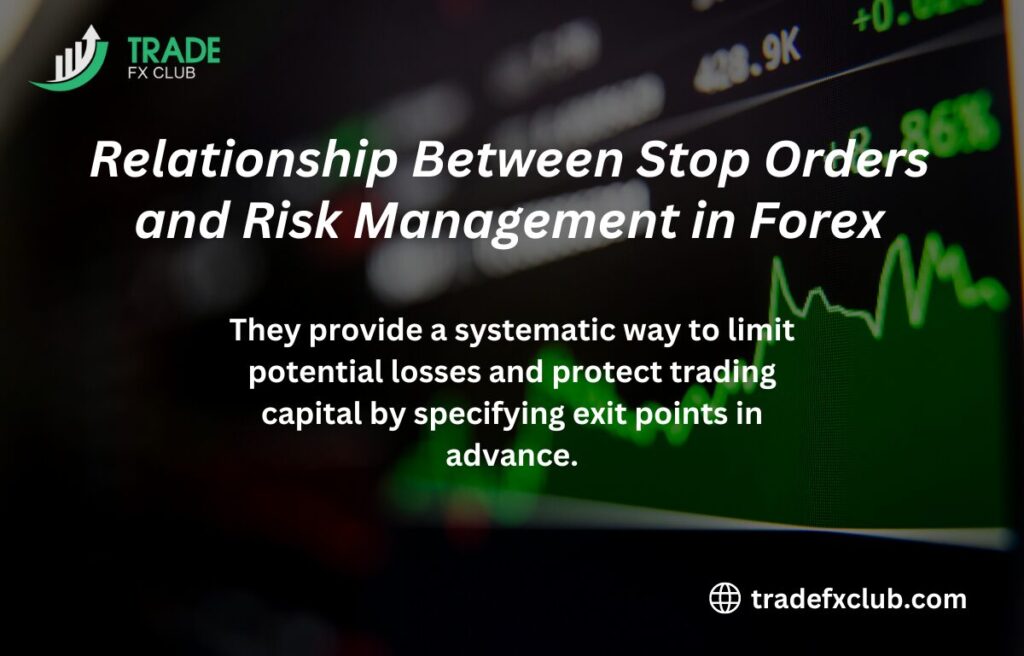
Furthermore, stop orders can be used to manage risk in various market conditions and trading strategies. For example, trailing stops help secure profits by adjusting the stop level as the market moves favourably, thereby protecting gains while allowing for potential further profits. Integrating stop-orders into a comprehensive risk management plan helps traders balance risk and reward, enhance decision-making, and achieve long-term trading success.
Stop-orders are essential tools in Forex trading, offering critical functions for risk management and strategy execution. They help protect trades by setting predefined exit points, which can limit potential losses and secure profits. Stop-loss orders, stop-limit orders, and trailing stops each serve distinct purposes, allowing traders to adapt their risk management strategies to various market conditions. By using stop orders effectively, traders can maintain discipline, avoid emotional decision-making, and manage their trades more systematically.
However, the use of stop-orders is not without its complexities. Market conditions, such as volatility and liquidity, can impact the effectiveness of stop-orders, leading to issues like slippage and unexecuted orders. Additionally, managing multiple stop orders requires careful planning and the use of appropriate trading tools to ensure that each order aligns with the overall strategy. Understanding the relationship between stop orders and risk management is crucial for optimising trading performance and achieving long-term success in the Forex market.

